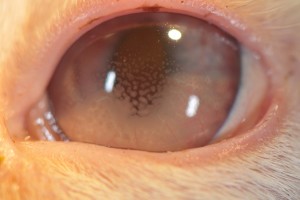
Signs of a uveitis episode can include a small pupil, blue color change to the cornea (clear part of the eye), darkening of the normal iris color and redness in the white part of the eye.
The uveal tract consists of the iris (the colored part of the eye), ciliary body and choroid. (The ciliary body and choroid are not visible when looking at the eye externally.) Uveitis is inflammation of some or all parts of the uveal tract. During an episode of uveitis, white blood cells and other inflammatory proteins are able to enter the eye.
Uveitis can lead to secondary changes such as glaucoma.
Although the causes for uveitis are numerous, they can be broken down into major groups consisting of infectious processes (usually caused by bacteria, fungi or other microorganisms), cancer, trauma and autoimmune conditions.
Because of the vast array of causes, a veterinarian may recommend a variety of diagnostic tests consisting of blood tests, infectious disease testing and radiographs (X-rays) of the chest and abdomen. These tests are useful because if they identify a cause for the uveitis, a more specific and effective treatment regimen can be formulated. Often the cause cannot be identified despite exhaustive testing; however, treatment can still be pursued even if the cause is not known. Standard treatment for uveitis usually includes eye drops and oral medications.
During a uveitis episode you may notice the following clinical signs in your pet: small pupil, blue color change to the cornea (clear part of the eye), darkening of the normal iris color and redness in the sclera (white part of the eye). You may also notice that your pet is squinting, has excessive tearing, rubbing at the eyes or decreased vision. If you notice any of these signs, contact your veterinarian.



